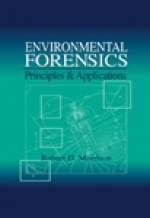Contains the most comprehensive information on environmental forensic techniques available in one publication
Describes the strengths and weaknesses of each forensic technique and how to scientifically challenge an inappropriately selected method
Offers both published information and "real world" use of techniques in litigation to assist the reader in discriminating between legitimate scientific techniques and "junk science"
Acts as a stand-alone reference for the environmental consultant in the selection of a dating/timing technique that is most applicable to his/her site and/or client
Serves as a stand-alone reference for the attorney in presenting an understanding of chemicals applicable to his/her case
Offering state-of-the-art techniques for both attorneys and environmental scientists, Environmental Forensics: Principles and Applications discusses non-chemical methods such as corrosion modeling, inventory reconciliation, and aerial photography interpretation. The book also covers chemical fingerprinting used to identify the origin and age of a contaminant release- relevant techniques include the use of radioactive isotope analysis, degradation modeling based on half-lives, and fuel additives such as MTBE.
Environmental Forensics provides case study examples of environmental trial exhibits. It covers misused techniques that can bias the scientific validity of a trial exhibit, such as scale exaggeration, use of statistical manipulation, data contouring, and selective presentation.
Detailed information is provided for identifying and interpreting those portions of environmental reports that are "target rich" sources of scientific biases. These include the identification of false positive, false negative and the intentional manipulation of environmental data that occurs primarily in the sample collection process.
The Author
Acknowledgments
Chapter 1 : An Overview of the History, Chemistry, and Transport of Chlorinated Solvents
Chapter 2 : Chemistry and Transport of Petroleum Hydrocarbons
Chapter 3 : Identification of Biased Environmental Data
Chapter 4 : Forensic Techniques Used in Environmental Litigation
Chapter 5 : Contaminant Transport Modeling
Chapter 6 : Forensic Review of Environmental Trial Exhibits
Appendices
A : Sample Calculation for the Transport of PCE Vapor through Concrete Pavement
B : Sample Calculation for the Transport of PCE Liquid through Concrete via Diffusion
C : Properties of Alcohol Oxygenates and Ether Oxygenates
D : Advective and Partitioning Transport Equations of Radon for Detecting Diesel in Groundwater
E : Chemical and Commercial Synonyms for Selected Chlorinated Solvents and Aromatic Hydrocarbons
F : Laboratory Terms and Definitions
Index

























